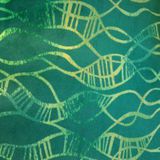


Lobular Panniculitis
A 62-year-old man with chronic hepatitis C virus infection and alcohol-induced cirrhosis presented after 10 days of epigastric pain and vomiting. The serum lipase level was 6715 U per liter (reference range, 0 to 160). A computed tomographic image showed peripancreatic inflammation and a large fluid collection in the right side of the abdomen that was thought to represent a pancreatic pseudocyst (Panel A, arrow). The patient was treated supportively for acute alcoholic pancreatitis, and percutaneous drainage of the pseudocyst was performed. On hospital day five, annular, pink, blanching areas, measuring 2 cm by 2 cm, developed on the distal anterior thighs, with underlying subcutaneous, nontender nodules measuring 1 cm by 1 cm (Panel B), which became increasingly tender during the next several days. Histopathological examination of a skin-biopsy specimen showed lobular panniculitis (Panel C, arrow), with fat necrosis and focal saponification (arrowhead). The patient had a prolonged hospital stay and needed total parenteral nutrition and surgery for recurrent pseudocyst. The nodules resolved over the course of 2 weeks. Pancreatic panniculitis is an uncommon complication of pancreatitis. The liberation of pancreatic enzymes into the circulation causes fat necrosis in distal panni and the formation of subcutaneous nodules. The nodules regress with improvement in pancreatitis.
Very interesting look at an addition to complication of pancreatitis
I was diagnosed as a Hepatitis B carrier in 2015, with early signs of liver fibrosis. At first, antiviral medications helped control the virus but over time, resistance developed, and the effectiveness faded. I began to lose hope. In 2021, I discovered NaturePath Herbal Clinic despite my skepticism, I decided to give their herbal treatment a try.To my surprise, after just six months, my blood tests came back negative for the virus.It was nothing short of life-changing.I never expected such incredible results from a natural treatment. But it not only cleared the virus it restored my hope, my health, and my peace of mind.If you or someone you know is battling Hepatitis B, I truly encourage you to explore the natural healing path offered by NaturePath Herbal Clinic. It gave me a second chance and it might do the same for you.www.naturepathherbalclinic.com info@naturepathherbalclinic.com



